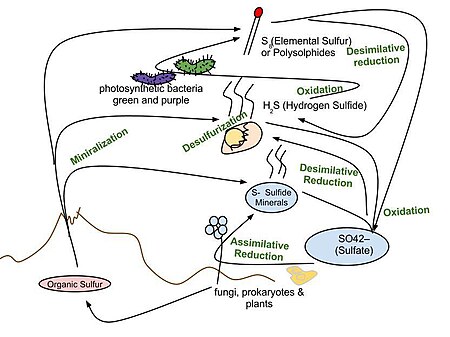Sulfate-reducing bacteria are those bacteria and archaea that can obtain energy by oxidizing organic compounds or molecular hydrogen (H2) while reducing sulfate (SO2âˆ'
4) to hydrogen sulfide (H2S). In a sense, these organisms "breathe" sulfate rather than oxygen in a form of anaerobic respiration.
Sulfate-reducing bacteria can be traced back to 3.5 billion years ago and are considered to be among the oldest forms of microorganisms, having contributed to the sulfur cycle soon after life emerged on Earth.
Many bacteria reduce small amounts of sulfates in order to synthesize sulfur-containing cell components; this is known as assimilatory sulfate reduction. By contrast, the sulfate-reducing bacteria considered here reduce sulfate in large amounts to obtain energy and expel the resulting sulfide as waste; this is known as dissimilatory sulfate reduction. They use sulfate as the terminal electron acceptor of their electron transport chain. Most of them are anaerobes; however there are examples of sulfate-reducing bacteria that are tolerant of oxygen. Under oxygenated conditions these bacteria switch to aerobic respiration before reducing sulfate
Most sulfate-reducing bacteria can also reduce other oxidized inorganic sulfur compounds, such as sulfite, thiosulfate, or elemental sulfur (which is reduced to hydrogen sulfide).
In addition, there are sulfate-reducing bacteria that can reduce fumarate, nitrate and nitrite, iron (Fe(III)) and some other metals, dimethyl sulfoxide and even oxygen.
Ecological importance and markers

Sulfate occurs widely in seawater, sediment, or water rich in decaying organic material. Sulfate-reducing bacteria are common in anaerobic environments where they aid in the degradation of organic materials. In these anaerobic environments, fermenting bacteria extract energy from large organic molecules; the resulting smaller compounds such as organic acids and alcohols are further oxidized by acetogens and methanogens and the competing sulfate-reducing bacteria.
The toxic hydrogen sulfide is a waste product of sulfate-reducing bacteria; its rotten egg odor is often a marker for the presence of sulfate-reducing bacteria in nature. Sulfate-reducing bacteria are responsible for the sulfurous odors of salt marshes and mud flats. Much of the hydrogen sulfide will react with metal ions in the water to produce metal sulfides. These metal sulfides, such as ferrous sulfide (FeS), are insoluble and often black or brown, leading to the dark color of sludge.
During the Permianâ€"Triassic extinction event (250 million years ago) a severe anoxic event seems to have occurred where these forms of bacteria became the dominant force in oceanic ecosystems, producing copious amounts of hydrogen sulfide.
Uses
Some sulfate-reducing bacteria can reduce hydrocarbons such as benzene, toluene, ethylbenzene, and xylene, and have been used to clean up contaminated soils. Their use has also been proposed for other kinds of contaminations.
Sulfate-reducing bacteria are considered as a possible way to deal with acid mine waters that are produced by other bacteria.
Problems caused by sulfate-reducing bacteria

In engineering, sulfate-reducing bacteria can create problems when metal structures are exposed to sulfate-containing water: Interaction of water and metal creates a layer of molecular hydrogen on the metal surface; sulfate-reducing bacteria then oxidize the hydrogen while creating hydrogen sulfide, which contributes to corrosion.
Hydrogen sulfide from sulfate-reducing bacteria also plays a role in the biogenic sulfide corrosion of concrete. It also occurs in sour crude oil.
Some sulfate-reducing bacteria play a role in the anaerobic oxidation of methane:
- CH4 + SO42âˆ' â†' HCO3âˆ' + HSâˆ' + H2O
An important fraction of the methane formed by methanogens below the seabed is oxidized by sulfate-reducing bacteria in the transition zone separating the methanogenesis from the sulfate reduction activity in the sediments. This process is also considered a major sink for sulfate in marine sediments.
In hydrofracturing fluids used to frack shale formations to recover methane (shale gas), biocide compounds are often added to water to inhibit the microbial activity of sulfate-reducing bacteria in order to avoid anaerobic methane oxidation and to minimize potential production loss.
Biochemistry
Before sulfate can be used as an electron acceptor, it must be activated. This is done by the enzyme ATP-sulfurylase, which uses ATP and sulfate to create adenosine 5'-phosphosulfate (APS). APS is subsequently reduced to sulfite and AMP. Sulfite is then further reduced to sulfide, while AMP is turned into ADP using another molecule of ATP. The overall process, thus, involves an investment of two molecules of the energy carrier ATP, which must to be regained from the reduction.
Phylogeny
The sulfate-reducing bacteria have been treated as a phenotypic group, together with the other sulfur-reducing bacteria, for identification purposes. They are found in several different phylogenetic lines. As of 2009, 60 genera containing 220 species of sulfate-reducing bacteria were known.
Among the Deltaproteobacteria the orders of sulfate-reducing bacteria include: Desulfobacterales, Desulfovibrionales and Syntrophobacterales. This accounts for the largest group of sulfate-reducing bacteria, about 23 genera.
The second largest group of sulfate-reducing bacteria is found among the Firmicutes, including the genera Desulfotomaculum, Desulfosporomusa, and Desulfosporosinus.
In the Nitrospirae division we find sulfate-reducing Thermodesulfovibrio species.
Two more groups that include thermophile sulfate-reducing bacteria are given their own phyla, the Thermodesulfobacteria and Thermodesulfobium.
There are also three genera of Archaea known to be capable of sulfate reduction: Archaeoglobus, Thermocladium and Caldivirga. They are found in hydrothermal vents, oil deposits, and hot springs.
See also
- Microbial metabolism
- Anaerobic respiration




0 komentar :
Posting Komentar